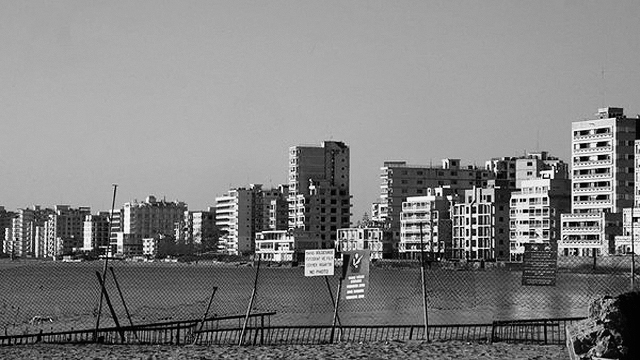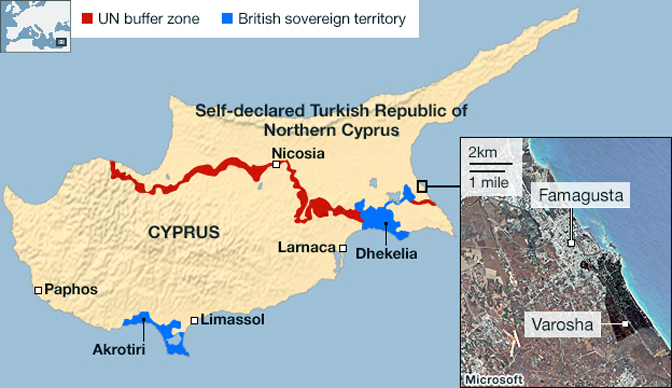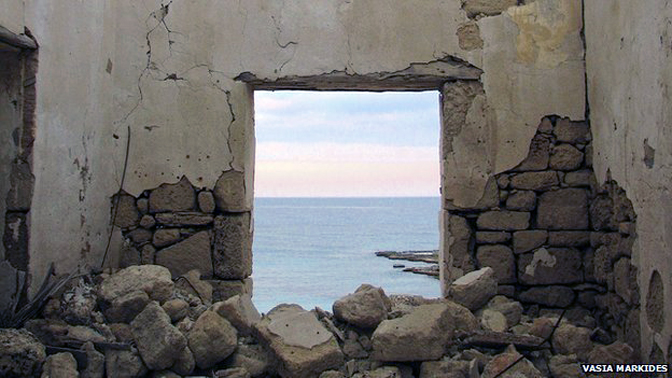 Δεν εγκαταλείπουν την προσπάθεια για το άνοιγμα της Αμμοχώστου οι Αμερικανοί. Το κατέστησε σαφές χθες βράδυ ο Αμερικανός αντιπρόεδρος Τζο Μπάιντεν ο οποίος, μπροστά στις συνεχιζόμενες ενστάσεις προφανώς του Έρογλου, επέλεξε να κάνει δεύτερη δήλωση χωρίς την παρουσία των δύο ηγετών για να πει αυτό ακριβώς το πράγμα.
Δεν εγκαταλείπουν την προσπάθεια για το άνοιγμα της Αμμοχώστου οι Αμερικανοί. Το κατέστησε σαφές χθες βράδυ ο Αμερικανός αντιπρόεδρος Τζο Μπάιντεν ο οποίος, μπροστά στις συνεχιζόμενες ενστάσεις προφανώς του Έρογλου, επέλεξε να κάνει δεύτερη δήλωση χωρίς την παρουσία των δύο ηγετών για να πει αυτό ακριβώς το πράγμα.
Δήλωσε την απόφαση των ΗΠΑ να βοηθήσουν στο άνοιγμα της Αμμοχώστου εάν οι δύο πλευρές συμφωνήσουν στο πακέτο των ΜΟΕ. Σημειώνεται ότι ο κ. Μπάιντεν δεσμεύτηκε στον Πρόεδρο Αναστασιάδη ότι θα συνεχίσει προσωπικά τις προσπάθειες για το θέμα αυτό. Με τις δύο δηλώσεις που έκανε ο κ. Μπάιντεν, δεν άφησε καμία αμφιβολία σε ποιου τα χέρια βρίσκεται πλέον το Κυπριακό. Ανακοίνωσε την εντατικοποίηση των συνομιλιών με δύο συναντήσεις των ηγετών κάθε μήνα, την επαναλειτουργία των δικοινοτικών επιτροπών και την ενίσχυση του έργου για διακρίβωση της τύχης των αγνοουμένων.
Συμφώνησαν σε επίσπευση της διαδικασίας των διαπραγματεύσεων
Σε επίσπευση της διαδικασίας των διαπραγματεύσεων συμφώνησαν οι ηγέτες των δυο κοινοτήτων στην Κύπρο οι οποίοι θα συναντώνται τουλάχιστον δυο φορές το μήνα, δήλωσε απόψε ο Αντιπρόεδρος των ΗΠΑ Τζο Μπάιντεν, υπενθυμίζοντας πως η επόμενη συνάντηση των ηγετών θα πραγματοποιηθεί στις 2 Ιουνίου. Ο κ. Μπάιντεν προέβη σε δηλώσεις μετά το δείπνο σε εστιατόριο στη νεκρή ζώνη, πλαισιωμένος από τους δυο ηγέτες – τον Πρόεδρο της Δημοκρατίας Νίκο Αναστασιάδη και τον Τ/κ ηγέτη Ντερβίς Ερογλου – την Ειδική Αντιπρόσωπο του ΓΓ του ΟΗΕ στην Κύπρο Λίζα Μπάτενχαϊμ και τους διαπραγματευτές των δυο κοινοτήτων Ανδρέα Μαυρογιάννη και Κουντρέτ Οζερσάι.
Οπως είπε ο κ. Μπάιντεν οι δυο ηγέτες επαναβεβαίωσαν την πλήρη δέσμευσή τους στο κοινό ανακοινωθέν της 11ης Φεβρουαρίου. Μετά την αρχική του δήλωση και αφού αποχώρησαν οι ηγέτες, η κ. Μπάτενχαϊμ και οι δυο διαπραγματευτές, ο κ. Μπάιντεν, ο οποίος αναχώρησε απόψε από την Κύπρο, συνέχισε τις δηλώσεις του, αναφέροντας πως εάν υπάρξει συμφωνία για το θέμα της Αμμοχώστου οι ΗΠΑ είναι έτοιμες να βοηθήσουν στην εφαρμογή της. Στις αρχικές του δηλώσεις ο Αντιπρόεδρος των ΗΠΑ είπε ότι το γεγονός ότι συνέφαγαν μαζί στην καρδιά μιας όμορφης και αρχαίας πόλης, αλλά επίσης στη νεκρή ζώνη που διαχωρίζει τη μία κοινότητα από την άλλη «μας υπενθυμίζει ότι τα πράγματα δεν ήταν πάντοτε όπως είναι τώρα”, προσθέτοντας ότι “δεν είναι ανάγκη να παραμείνουν ως έχουν, ένας καλύτερος δρόμος έχει ανοίξει”.
Συνέχισε λέγοντας ότι «οι δύο ηγέτες συμφώνησαν να επισπεύσουν τη διαδικασία των διαπραγματεύσεων προς μια συνολική λύση, κάτι που αποτελεί προτεραιότητα γι` αυτούς». Συμφώνησαν επίσης, είπε, “να εντείνουν την εργασία τους για την προετοιμασία ουσιωδών μέτρων οικοδόμησης εμπιστοσύνης όπως προνοεί η κοινή δήλωση».
«Οι δύο ηγέτες συμφώνησαν επίσης να αναζωογονήσουν τις δικοινοτικές τεχνικές επιτροπής για να βελτιώσουν την καθημερινότητα Ε/κ και Τ/κ», πρόσθεσε. Παράλληλα, ανέφερε, ότι οι δύο ηγέτες συμφώνησαν να καλέσουν από κοινού όλους όσοι έχουν οποιαδήποτε πληροφορία για αγνοούμενους να μοιραστούν αυτή την πληροφορία με την Διερευνητική Επιτροπή για τους Αγνοούμενους, για να βοηθήσουν το έργο της. Συμφώνησαν, συμπλήρωσε, ότι θα δοθούν επιπρόσθετοι πόροι για το έργο της Επιτροπής.
Την ίδια ώρα υποσχέθηκε ότι οι ΗΠΑ θα συνεχίσουν τις επαφές τους με όλα τα ενδιαφερόμενα μέρη για να διερευνήσουν πρωτοβουλίες οι οποίες θα είναι επωφελείς για αμφότερες τις πλευρές, ώστε να ενισχύσουν τις διαπραγματεύσεις.
Μετά την αποχώρηση αυτών που τον πλαισίωναν, ο κ. Μπάιντεν προέβη σε μερικές επιπρόσθετες δηλώσεις, εκφράζοντας αισιοδοξία για το μέλλον και κάνοντας αναφορά ειδικότερα στο ρόλο των ΗΠΑ στη διαδικασία. Είπε ότι εντυπωσιάστηκε από την εγκαρδιότητα και την άνεση με την οποία οι δύο ηγέτες συνομιλούν και διαπραγματεύονται μεταξύ τους. Συνέχισε σημειώνοντας ότι απόψε άκουσε και τους δύο ηγέτες να επαναβεβαιώνουν ένα κοινό στόχο, “την επανένωση της Κύπρου ως μια διζωνική, δικοινοτική ομοσπονδία». Είπε ακόμη ότι υπήρχε κοινό έδαφος σε μερικές πτυχές των διαπραγματεύσεων αλλά και διαφορές. Ωστόσο εξέφρασε τη θέση ότι «οι διαφορές αυτές δεν είναι ανυπέρβλητες». Υπάρχει ξεκάθαρα πολλή δουλειά που πρέπει να γίνει «αλλά αυτά που ακούω, μου δίνουν ελπίδα ότι η λύση είναι εφικτή αυτή τη φορά», πρόσθεσε. Οι ΗΠΑ ενθαρρύνουν τους ηγέτες να συζητήσουν το πακέτο για τα Βαρώσια και την Αμμόχωστο και αν οι δύο πλευρές συμφωνήσουν οι ΗΠΑ «είναι έτοιμες να βοηθήσουν στην εφαρμογή», τόνισε.
Ανέφερε ακόμη ότι η χώρα του ελπίζει «να δει γρήγορη και ουσιαστική πρόοδο σε μια σειρά από βασικά ζητήματα που θα επιτρέψουν στις πλευρές να εισέλθουν στην τελική φάση των διαπραγματεύσεων υπό την αιγίδα των Ηνωμένων Εθνών».
Στο τέλος της ημέρας, επεσήμανε, «η λύση δεν μπορεί να έλθει από έξω». Δεν μπορεί, πρόσθεσε, «να έλθει από τις ΗΠΑ ή από οπουδήποτε αλλού». Πρέπει, είπε, «να έρθει από τους ηγέτες των δύο κοινοτήτων» και την κοινωνία πολιτών, τις φωνές της οποίας άκουσε ο ίδιος, όπως είπε, νωρίτερα σήμερα.
Με ρωτούν, ανέφερε, τί συμφέρον έχουν οι ΗΠΑ από αυτό, για να απαντήσει ότι «ο Πρόεδρος Ομπάμα και εγώ, πιστεύουμε ότι η Κύπρος είναι σημαντικός εταίρος σε μια περιοχή με προκλήσεις και γνωρίζουμε ότι μπορεί να καταστεί ακόμη πιο ισχυρός εταίρος αν η επόμενη γενεά Κυπρίων μεγαλώσει χωρίς το βάρος του προβλήματος». Αυτό, επεσήμανε, θα άνοιγε τους ορίζοντές τους και θα τους επέτρεπε να κάνουν πολύ πιο σπουδαία όνειρα. Εξέφρασε την άποψη ότι «η Κύπρος μπορεί να αναπτυχθεί σε δύναμη ειρήνης, ευημερίας και σταθερότητας στην Ανατολική Μεσόγειο και αυτό θα ήταν προς όφελος του κόσμου». Θα ήταν, πρόσθεσε, «προς όφελος όλων μας». Πάντα θα υπάρχουν αυτοί που αμφισβητούν, είπε, προσθέτοντας όμως ότι «απόψε άκουσα δύο ηγέτες που είναι δεσμευμένοι να τους αποδείξουν ότι έχουν άδικο».
Εκανε σε ποίημα του Ιρλανδού ποιητή Σέιμους Χίνι, ο οποίος έγραψε ότι «Η ιστορία λέει, Μην ελπίζεις / Από αυτή την πλευρά του τάφου / Ομως, κάποια φορά σε αυτή τη ζωή / Το πιο μεγάλο παλιρροιακό κύμα δικαιοσύνης μπορεί να σηκωθεί / Και η ελπίδα και η ιστορία ομοιοκαταληκτούν». Για το καλό των αγοριών και των κοριτσιών που γεννήθηκαν σ` αυτό το νησί, που τους αξίζει η προοπτική που μόνο η ειρήνη μπορεί να φέρει, ας κάνουμε επιτέλους την ελπίδα και την ιστορία να ομοιοκαταληκτήσουν, ανέφερε ο κ. Μπάιντεν.
From: politis-news.com May 23, 2014















 Πιο εμφανή δεν μπορούσαν να καταστήσουν οι Αμερικανοί το ρόλο που θέλουν να διαδραματίσουν στην παρούσα προσπάθεια επίλυσης του Κυπριακού.
Πιο εμφανή δεν μπορούσαν να καταστήσουν οι Αμερικανοί το ρόλο που θέλουν να διαδραματίσουν στην παρούσα προσπάθεια επίλυσης του Κυπριακού.